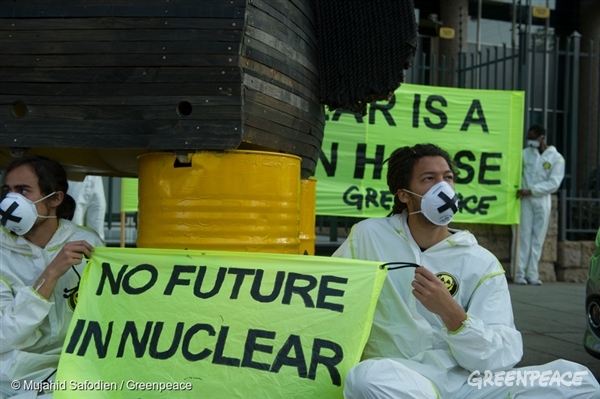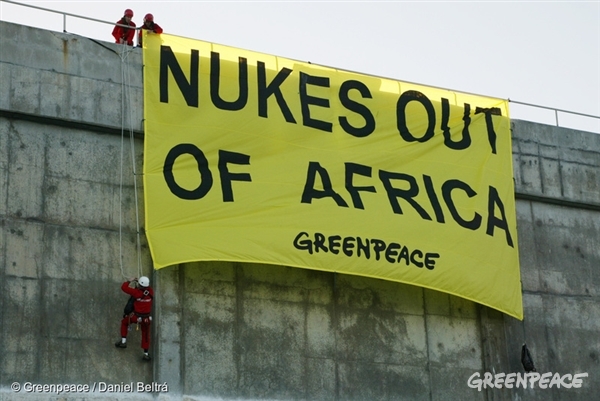
Greenpeace activists from five countries launched a pre-dawn protest at Koeberg, Africa’s only nuclear power plant as world leaders gather in Johannesburg for the Earth Summit. Six activists climbed onto the roof of nearby buildings before dropping a banner that read “Nukes Out of Africa”.
Nuclear tests have shaped Greenpeace. They have been a part of our story as an organisation from the outset. They have been a part of my own story, both personally and professionally.
I was 24 when I first witnessed, in person, the disastrous impacts of nuclear testing on people, and on the environment. It was 1985 and I was sailing as a deckhand aboard the Greenpeace Ship, the Rainbow Warrior, on an anti-nuclear campaign in the Pacific. Our first mission was to help 360 members of the Rongelap community to relocate away from their home island in the Marshall Islands in the North Pacific to escape contamination from a round of US nuclear testing some years earlier.
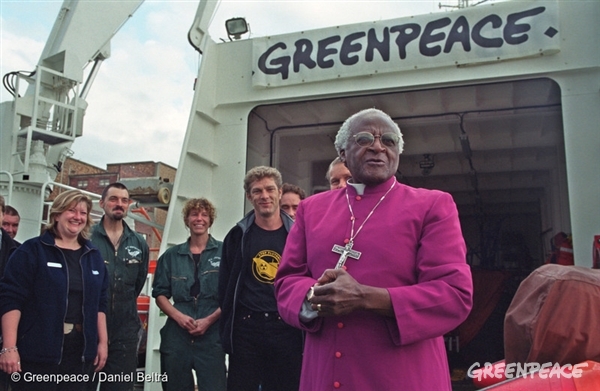
Archbishop Desmond Tutu visited the Greenpeace ship MV Esperanza while it was in Cape Town. He blessed the vessel and the crew and then joined them in wishing for a clean, peaceful and nuclear free world.
For ten days we helped women, men, elderly and children, many suffering the medical consequences of being exposed to radiation. They had to leave a beloved homeland populated by their ancestors for decades. The land they loved could no longer sustain them – instead it was making them sick. The tragedy inflicted on them was by no fault of their own. Those inflicting it did so with little or no regard to those being impacted. In fact they were glibly told “it was for the good of mankind and to end all world wars.” The stupidity behind the thinking that weapons of mass destruction were the path to real security and peace unfortunately has not left many of the halls of power even today. This little known story in the Pacific deeply affected all of us involved and it was clear that the connection between the violence we do to Earth and the violence we do to people mattered little to those who were doing it.
From Rongelap we sailed to New Zealand. The Rainbow Warrior was supposed to lead a flotilla of boats sailing east to Moruroa in French Polynesia, where the French authorities were doing their nuclear testing. Our plans were dramatically altered in a manner none of us could predict. On July 101985, French secret service agents, under orders from their government, planted two bombs on the hull of the Rainbow Warrior. The bombs exploded and the boat sank within minutes. Our friend and colleague Fernando Pereira, was murdered in the blast.
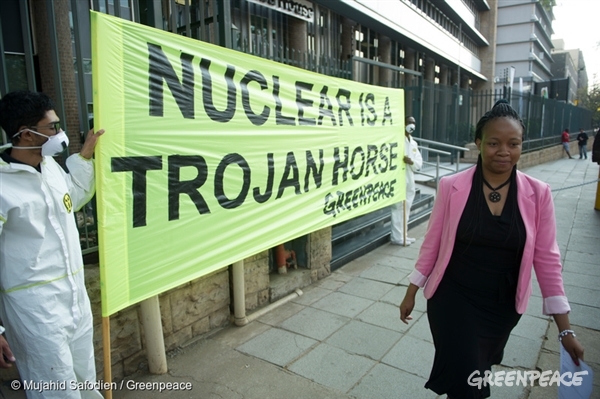
Greenpeace activists protest outside the Department of Energy headquarters in Pretoria against the Department’s lack of transparency around proposed investments in nuclear energy, and to remind the Minister that the nuclear plan is nothing less than a trap – a Trojan horse with a price tag South Africans cannot afford.
Our Rainbow Warrior never made it to Moruroa. She was damaged beyond repair. She was there in spirit though. An even bigger flotilla of yachts sailed to the Pacific to protest the nuclear testing. Money was raised to help pay for a new Rainbow Warrior, which returned to the Pacific many times, until the testing was stopped in 1996.
Things are different now. Full-scale nuclear testing has largely come to a halt thanks to people who stood up, and kept standing up, in the thousand different ways it takes to change the course of history. Governments, who for decades argued that nuclear tests were ‘clean’ and ‘safe’ can no longer hold on to that lie.
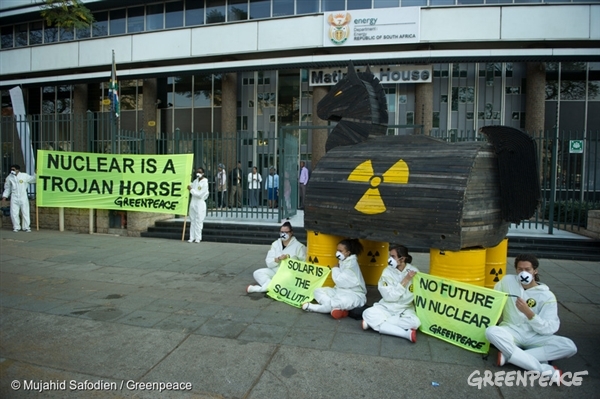
Nuclear is nothing less than a trap – a Trojan horse with a price tag South Africans cannot afford.
Many details related to the tragic history of nuclear tests remain hidden, but the truth is coming out. Declassified papers from the French Ministry of Defence show that nuclear tests in the South Pacificin the 1960s and 1970s were far more toxic than has been previously acknowledged. Plutonium fallout hit the whole of French Polynesia. Tahiti, the most populated island, was exposed to 500 times the maximum accepted levels of radiation.
Justice has been painstakingly slow and incomplete for the victims of nuclear testing. Only in the early 1990s did the US acknowledge the damage caused to the Rongelapese and after long legal battles agreed to pay some compensation. It was not until 2010 that France acknowledged that there could be a compensation process (complex and limited to a small geographical area) for veterans and civilians impacted by the tests. Many victims are still struggling to be recognised.
Just like the trauma they inflict, the impact of the testing cannot be cleaned or erased – the contamination created by radiation will impact not only those living in the region now, but also future generations. There are no technologies capable of effectively cleaning up radiation. Nearly 30 years later, many of the Rongelapese still live in exile.
